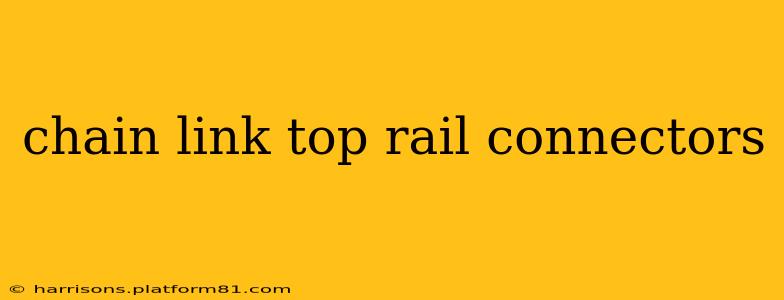Choosing the right chain link top rail connectors is crucial for ensuring a strong, secure, and long-lasting fence. This guide delves into the various types of connectors available, their applications, installation methods, and frequently asked questions to help you make an informed decision. Whether you're a seasoned fence installer or a DIY enthusiast tackling a home project, understanding these components is essential for fence construction success.
What are Chain Link Top Rail Connectors?
Chain link top rail connectors are small but vital components used to join sections of chain link fence together at the top rail. They provide structural integrity, ensuring the fence remains stable and secure against wind, pressure, and other external forces. These connectors come in various materials, including galvanized steel, aluminum, and vinyl, each offering distinct advantages and disadvantages. The choice depends heavily on the environment, budget, and aesthetic preferences.
Different Types of Chain Link Top Rail Connectors
Several types of top rail connectors exist, each with its own strengths:
-
Standard Rail Connectors: These are the most common type, typically made of galvanized steel and designed for straightforward joining of top rails. They often feature a simple clamp or sleeve design for easy installation.
-
Drive-in Connectors: These connectors are driven directly into the top rail using a mallet or hammer, offering a quick and efficient installation method. They’re particularly useful in situations where welding isn't feasible or desirable.
-
Welded Connectors: For maximum strength and durability, welded connectors permanently join the top rails. This method is often preferred in high-traffic areas or locations with harsh weather conditions. However, it requires welding equipment and expertise.
How to Install Chain Link Top Rail Connectors?
The installation process varies slightly depending on the connector type, but generally involves these steps:
-
Preparation: Ensure the top rails are aligned and properly positioned.
-
Connection: Insert or clamp the connector according to the manufacturer's instructions. For drive-in connectors, use a mallet to securely fasten the connector into the rail. For standard connectors, ensure a tight and secure fit. For welded connectors, use appropriate welding techniques to create a strong and lasting bond.
-
Inspection: After installation, visually inspect the connection to ensure its stability and security.
What Size Chain Link Top Rail Connectors Do I Need?
The size of the connector depends on the diameter of your top rail. Always check the specifications provided by the manufacturer to ensure compatibility. Using the incorrect size can compromise the structural integrity of the fence.
Are Chain Link Top Rail Connectors Galvanized?
Many chain link top rail connectors are galvanized to protect them from rust and corrosion. Galvanization is a process that applies a protective zinc coating to the metal, increasing its lifespan and durability, especially in outdoor environments.
How Much Do Chain Link Top Rail Connectors Cost?
The cost of chain link top rail connectors varies based on the type, material, and quantity. Generally, standard galvanized steel connectors are the most affordable option. However, factors like the supplier and purchasing volume will also influence the final price.
Where to Buy Chain Link Top Rail Connectors?
Chain link top rail connectors can be purchased at various retailers, including home improvement stores, fencing supply companies, and online marketplaces. When purchasing, always ensure you select connectors compatible with your existing fencing materials and specifications.
Conclusion
Choosing the right chain link top rail connectors is vital for building a durable and secure fence. Understanding the different types available, their installation, and their cost allows you to make an informed decision that meets your specific needs and budget. By considering factors such as material, durability, and installation method, you can ensure your chain link fence stands the test of time. Remember always to consult with a professional if you are unsure about any aspect of the installation process.
